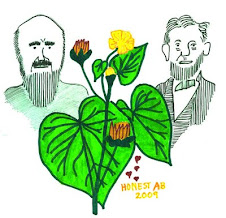I
ran across an old book in my office yesterday. It is not old enough of a book
to be historically important, like The
Malay Archipelago by Alfred Russel Wallace, nor is it a classic like plant
ecologist John L. Harper’s Population
Biology of Plants. You probably cannot find this thirty-year-old paperback
anywhere except in the basement of an archiving library. It is Studies on Plant Demography: A Festschrift
for John L. Harper, edited by James White. John L. Harper (1925-2009) was
one of the most famous plant ecologists of the twentieth century. The scattershot
of 24 papers in this book gave examples of different ways to study plant
population biology, and reflect the great diversity of approaches that Harper
took in his own research. The papers in the book are about everything from weeds
to crops that act like weeds to pandanus trees to temperate forests. They
describe processes such as how plants spread by underground runners, to how
they space their branches out just right to help them compete against their
neighbors for light, to how they invade new continents. It represented the best
efforts of plant ecologists in 1985, back when illustrations were still done by
hand with mechanical pens and Zipatone.
I
planned to glance through the book a little and try to find a general take-home
message. I quickly realized there was none. But before I put the book in my
give-away pile, I had a sudden realization. The fact that there was no way to
summarize the book is the message.
Different species of plants, different populations of plants within the same
species, and even the same individual plant can have an enormous variety of
ways to not only survive but to spread and prevail over their competitors. I
looked up from the book and around at the plants in my back yard. Of course!
While none of the plants in my yard use all the different possible ways of
spreading, each one uses several. I had just finished cutting down hundreds of
sugarberry saplings. Birds spread their seeds, but that is not the only way sugarberries
persist in my yard. If you cut a
sugarberry sapling, a half dozen others will grow from its tiny stump.
Sugarberries thrive in the sun but also persist in the shade. I looked up at
the wisteria vines. Not only do they send thick and sometimes enormously long
branches through the privet bushes, but also along the ground, where they
produce roots at the nodes. I was watching a war of all the plants against all
the other plants in my yard, each one using numerous tactics or strategies. My
yard is not tidy; I have not forced my plants to keep to their own little patch
of ground spaced out like doodads on a blanket. I let them go wild, perhaps
naively thinking that they would play nicely together.
While
I might have expected simple rules in the natural world, what I beheld was a
crazy diversity.
There
was one other thing I noticed from this book. Near the beginning was a list of
all of John L. Harper’s publications as of 1985. His very first publications,
in 1950, were about the ability of different breeds of bananas to resist Panama
disease, a fungal pathogen. While Harper and the numerous ecologists who
followed him have mostly studied “pure science,” in an attempt to understand
nature, Harper himself began with an important concept in agricultural
research: we need lots of genetic diversity in our crops in order to save our
agriculture from disease. If a disease kills one breed of crop, we need to have
another breed to take its place. The crazy diversity of nature, or even of an
untidy back yard, is the key to the success of life on Earth.
